Fujian Tulou
By GUO ZHIDONG

Tulou, a type of earthen buildings, is a rural dwelling unique to the Hakka in Fujian, Jiangxi, and Guangdong provinces in southeastern China. It is a residential building built with earth, wood, stone, and bamboo as the main materials. It exemplifies a particular type of communal living and defensive structure.
Among them, the Fujian Tulou, or the Hakka earthen building, is the most widely distributed and best preserved. Known as the “treasure of traditional Fujian residential buildings,” Fujian Tulou enjoys a long history, rich cultural connotation, and unique functions.
THE Fujian Tulou is a Chinese rural dwelling unique to the Hakka in the mountainous areas in southeast Chinas Fujian Province. A Tulou is usually a large, enclosed, and fortified earthen building. The fortified structures are constructed by compacting raw earth, mixed with stone, bamboo, wood and other available materials, to form a large fortified building. As Tulou was mostly built by the Hakka people in Fujian, it is also known as the Hakka Tulou.
The earthen building has a long history, and its emergence was closely associated with the large-scale southward migration of the Central Plains residents in ancient times. Being affected by factors such as war, social unrest, and natural disasters, the people in the Central Plains of North China had moved southward in large numbers, many of whom moved to todays Fujian Province.
While avoiding conflict-prone areas, the people of the Central Plains who moved south brought the advanced culture, which then integrated and developed with that of local aborigines, providing an opportunity for the regions prosperity and development. In terms of residential structure, Tulou, with its unique architectural style, gradually emerged out of the Confucian concept of the big family living together, while also served a certain defense need. If an armed enemy plagued Tulou residents, as long as the young guarded the gates, the earthen building could become a strong fortress. The large, enclosed, and fortified appearance demonstrated strong defensive capabilities. Usually being occupied by one large family clan of several generations, the Tulou formed an independent society in a building, sharing weal or woe.
According to research and archaeological findings, at least before the Northern Song Dynasty (960-1127), a quite mature form of the Tulou had already appeared in Yongding County of Fujian Province. After the middle of the Ming Dynasty (1368-1644), as pirates and bandits often plagued both the southwestern mountainous and coastal areas of Fujian, this kind of construction was widely used. In the Qing Dynasty (1644-1911) and the Republic of China(1912-1949), with the development of the processing industry, the economy and trade of this region has further prospered. As they needed to safeguard the common interests of their clans and strengthen the defensive capabilities, the local residents often lived with dozens or even hundreds of people in one large family clan. The growth of the population promoted the development of the earthen buildings. This particular form of Tulou became diversified and sophisticated, and the decoration even integrated Chinese and Western elements with diverse functions. During this period, the development of Fujian Tulou reached its peak.

The structure of Tulou buildings varies, but it most commonly has a circular, semi-circular, square, quadrangular, pentagonal, or shovel shape. The interior space, composed of slender wooden components, is open to the inner courtyard. The standard open rooms take into full consideration the livability factor, which configured each independent space into an ideal environment for life, and also reflects the harmony between man and nature.
The Tulou in the early days was mostly square. As the corners of the square earthen buildings were darker, a feature which was not conducive to ventilation and lighting, the Hakkas designed a more optimized circular earthen building. This type is the most eye-catching one in existing Tulou clusters, which the locals call “the round buildings” or “the round villages.”
The round building is built around a circular center, spreading outwards according to different radii in a spectacular manner. The most central part is the family enclosure, which is enclosed by the ancestral hall and the porch, and the outermost ring is living areas for people of the family clan. Whether you look at it from a distance or up close, the Tulou is stunning as a massive monolithic architectural marvel. The diameter of a general-sized round building is about 50 meters with a height of three or four floors, which can accommodate 200 to 300 people. The large round building can reach 70 to 80 meters in diameter, with a height of five or six floors, which can accommodate 700 to 800 people. It fully embodies the folk customs of the Hakkas.
The Hakka people adhered to the cultural traditions before their move to the south, especially adhering to Confucianism, worshipping ancestors, and cherishing familial unity. This custom of living together as a big family reflects the strong ties of the family ethics system of the Hakka people and is also derived from the recognition of the traditional culture of the Central Plains. Among the dozens and hundreds of people living in the same building, all clan-oriented relationships, there are parents, brothers, sisters, uncles, aunts, and in-laws. One large family clan of several generations living under one roof has common ancestors. The highest elders have absolute authority, and people living in the same building share their property. Therefore, a history of an earthen building can be seen as a genealogical history of a clan. The descendants of Tulou often can tell the history of the family without reference to a genealogy.
There are 3,000-odd Fujian Tulou, mainly distributed in Longyans Yongding County and Zhangzhous Nanjing County and Huaan County of Fujian Province. Located in Dadi Village of Huaan County, Eryi Lou, known as the “King of Tulou” and the “National Treasure,” is regarded as an outstanding representative of Chinas ancient circular Tulou. As a wellreserved national key cultural relic protection site, it is famous for its large scale. On July 6, 2018, Fujian Tulou sites were inscribed by UNESCO as World Heritage Sites.
Fujian Hakka Tulou is rated as a gem of oriental civilization, a unique and incredible style of rural residential buildings in the world, and a highlight of ancient Chinese architecture. It stands out in the world of residential architecture designs with its long history, unique style, large scale, and exquisite structural presence.

